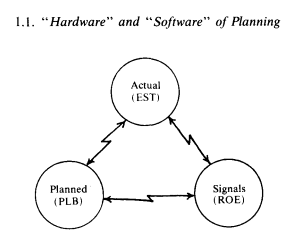Article contents
Actuarial Remarks on Planning and Controlling in Reinsurance
Published online by Cambridge University Press: 29 August 2014
Extract
Planning is, or ought to be, an ever-developing process in which virtually each member of the company has to be involved. Planning without controlling, i.e., without feedback, planning on its own, is useless.
In the first part of the present note, general aspects of planning are briefly described inasfar as they are relevant to possible treatment by actuarial methods.

The circles in the above figure represent what could be called the hardware of planning consisting of three sets of figures, namely
• Actual figures describing the most recent reality. Most of these figures are part of what is usually called the Earnings Statement (EST).
• Forecasts for the near future, say the next three years. Most of these figures are contained in the Planning Budget (PLB).
• Control figures or signals in the sense of a “bread-line” expressing, for example, how much the company should earn as a minimum in order to remain self-financing. Such figures are calculated on the basis of so-called Return on Equity considerations and they are found in a corresponding ROE-document.
By software we mean everything done with the hardware described above, i.e., primarily the comparison of figures from different domains of the hardware on different levels within the organisation of the company, the analysis, for example, of deviations between actual and planned, the conclusions to be taken from such analyses and the planning of new actions as a consequence.
In the above graph, circles symbolize the hardware and arrows indicate the software.
Also non-numeric planning instruments (e.g., project planning, action plans, assessment and decisions) are considered to be part of the planning software.
- Type
- Research Article
- Information
- Copyright
- Copyright © International Actuarial Association 1984
- 2
- Cited by


